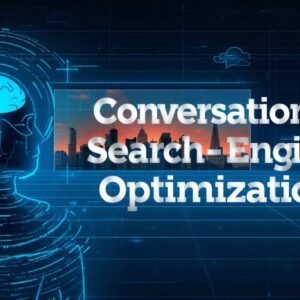Rise of Zero-Click and Zero-Intent SERPs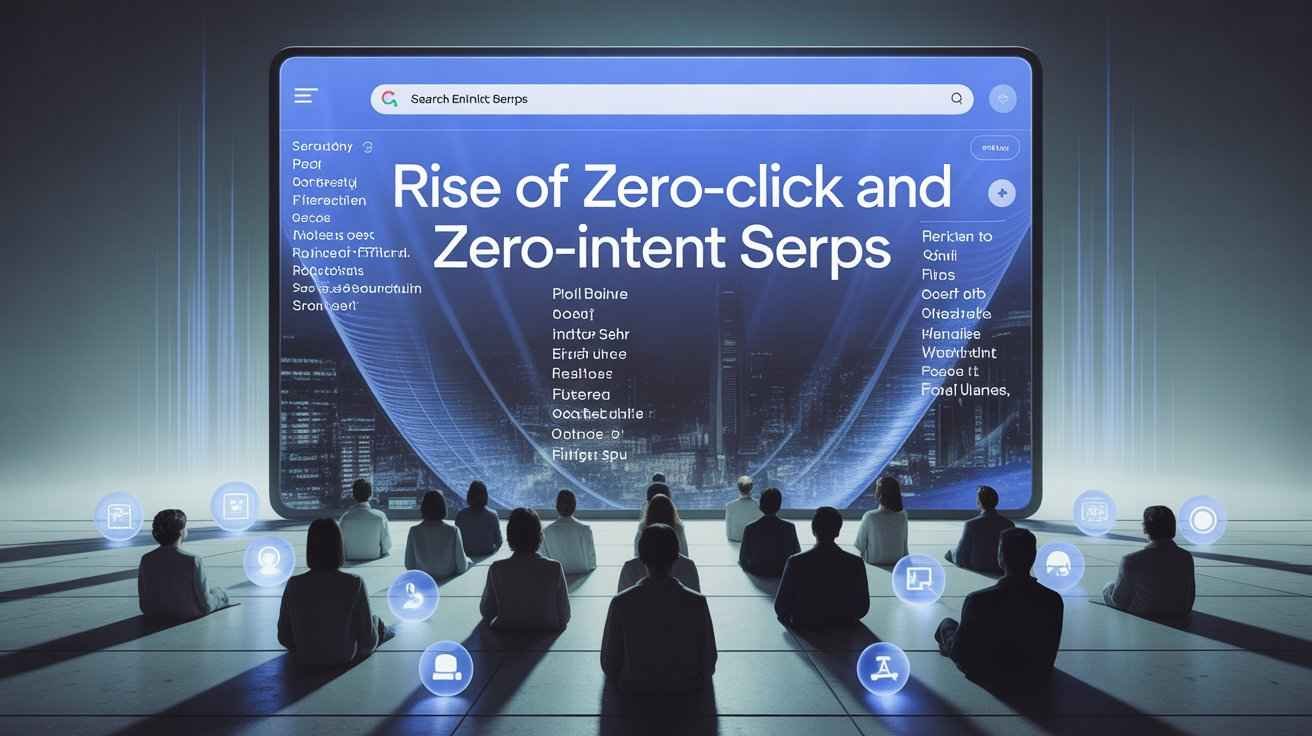
With more information served directly on search result pages, users often don’t click through. This compels marketers to focus on visibility via citations and structured snippets rather than relying on traffic.
Introduction: The Shift Toward On-SERP Answers
Zero-click searches occur when a query is answered directly on the search engine results page (SERP), eliminating the need for a site visit, and they have become a defining feature of modern search behavior as rich results, featured snippets, knowledge panels, and AI-generated summaries increasingly satisfy user needs in-SERP.
Zero-Intent SERPs describe results pages for broad or ambiguous queries where user goals aren’t yet explicit, prompting Google to surface overviews, People Also Ask modules, and entity-rich panels that help shape or clarify intent before any click decision is made. These trends matter in 2025 because organic clicks are eroding on many informational queries: multiple studies report lower CTRs where AI Overviews appear, highlighting a strategic shift from ranking alone to earning visibility within answer units and structured SERP features.
Defining what’s at stake begins with measurable shifts in engagement: analyses of hundreds of thousands of keywords in 2024–2025 show that queries triggering AI Overviews often experience notable organic CTR declines, especially for non-branded terms and lower-ranking positions, indicating that above-the-fold AI summaries crowd traditional listings and depress clicks further down the page. At the same time, large-scale panels tracking EU/UK behavior show a year-over-year drop in organic click share with a concurrent rise in zero-click actions, reinforcing that users increasingly complete tasks or get answers without leaving the SERP, a pattern most visible on mobile and informational intents characteristic of Zero-Intent SERPs.
For marketers, the implication is clear: optimize for on-SERP presence—citations in AI answers, featured snippets, and entity panels—alongside classic rankings to sustain brand visibility in a zero-click environment.
Google’s AI Overviews accelerate this shift by generating synthesized, source-attributed summaries at the top of the page that directly address user questions, which can reduce the relative visibility of traditional organic results and alter click distribution across positions.
While one controlled before/after analysis found that zero-click rates for the same keywords did not uniformly rise after AI Overviews appeared—suggesting the dynamic depends on query type and presentation—the broader pattern across multiple datasets still shows meaningful CTR pressure where AI summaries occupy prime real estate. In practice, this means that winning 2025 SERPs, especially for Zero-Intent SERPs, increasingly involves structured data, entity clarity, concise answer blocks, and content depth that earns inclusion and attribution inside Google’s on-page answers, not just top-10 blue link ranking
What Are Zero-Click and Zero-Intent Queries?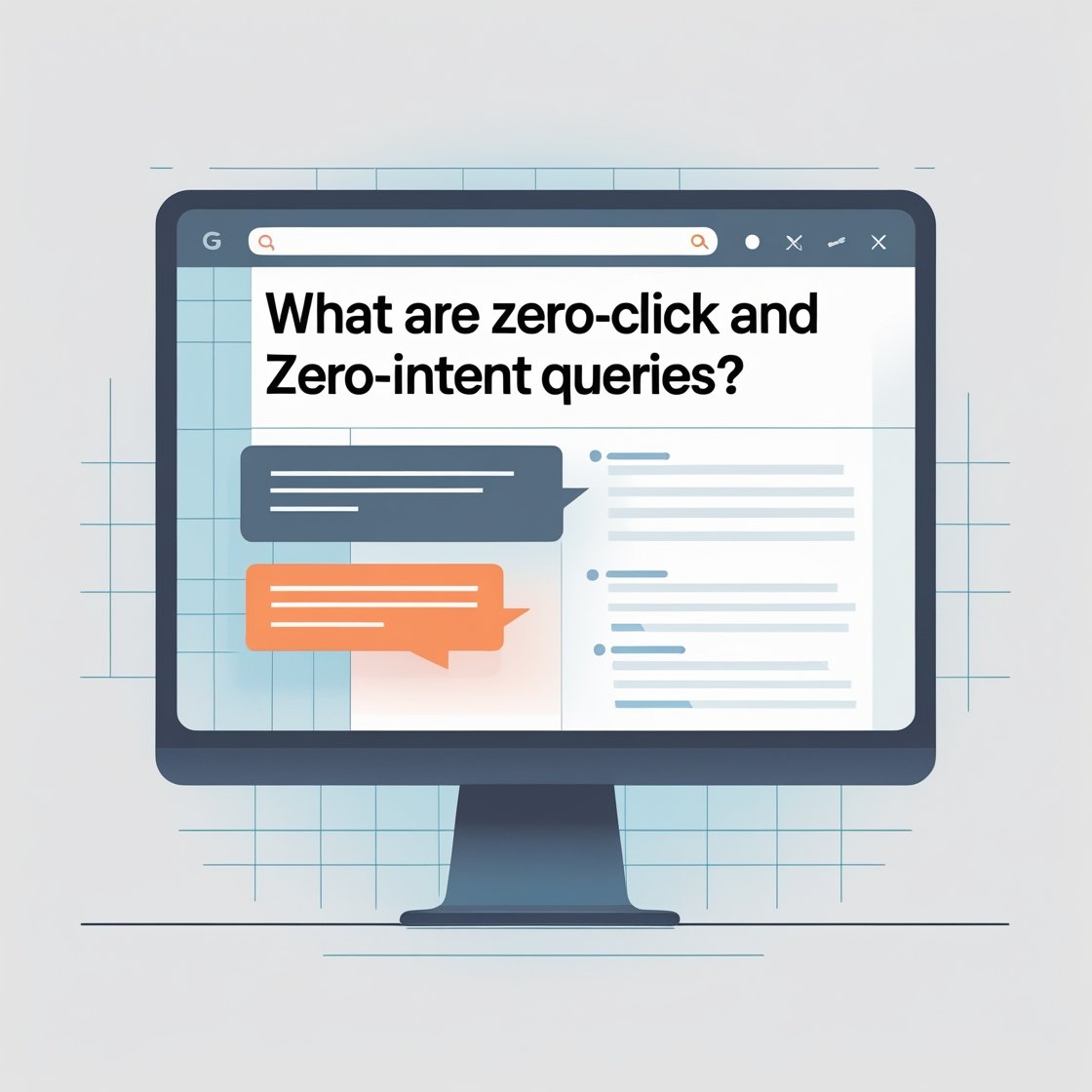
Zero-click searches are queries where the answer is presented directly on the search engine results page (SERP), so the user gets what they need without clicking through to any website, often via featured snippets, direct answer boxes, knowledge panels, or other rich results. Zero-Intent SERPs describe results pages for broad or exploratory queries where user goals are not yet explicit, prompting Google to surface overviews, People Also Ask (PAA) modules, and entity-rich elements that guide or refine intent before a click decision is made, which shifts the focus from driving traffic to earning on-SERP visibility and attribution.
Zero-click searches matter because they change how engagement is distributed: many informational lookups are satisfied on the page, reducing organic click-through rates and requiring brands to optimize for presence within SERP features instead of relying solely on blue-link rankings. In parallel, Zero-Intent SERPs increasingly use AI-generated overviews and intent-shaping elements to help searchers clarify needs, which can depress top-position CTRs where AI Overviews appear and reward results that secure citations or rich placements within those modules.
Common SERP features involved in zero-click and Zero-Intent SERPs include:
Featured snippets that extract concise answers from pages and appear in “position zero,” often satisfying queries without a click.
Knowledge panels that compile entity facts (e.g., people, brands, places), enabling instant answers on the SERP.
People Also Ask (PAA) accordions that surface related questions and short answers to shape user intent and exploration paths.
Local packs that fulfill local intent directly with maps, listings, reviews, calls, and directions—frequently resulting in zero-click interactions.
AI Overviews that provide AI-generated summaries at the top of results, correlating with lower CTR for top organic listings on many informational queries.
Carousels (e.g., videos, products, top stories) that present options inline on the SERP, facilitating discovery without immediate site visits.
The Data: How Click Behavior Is Changing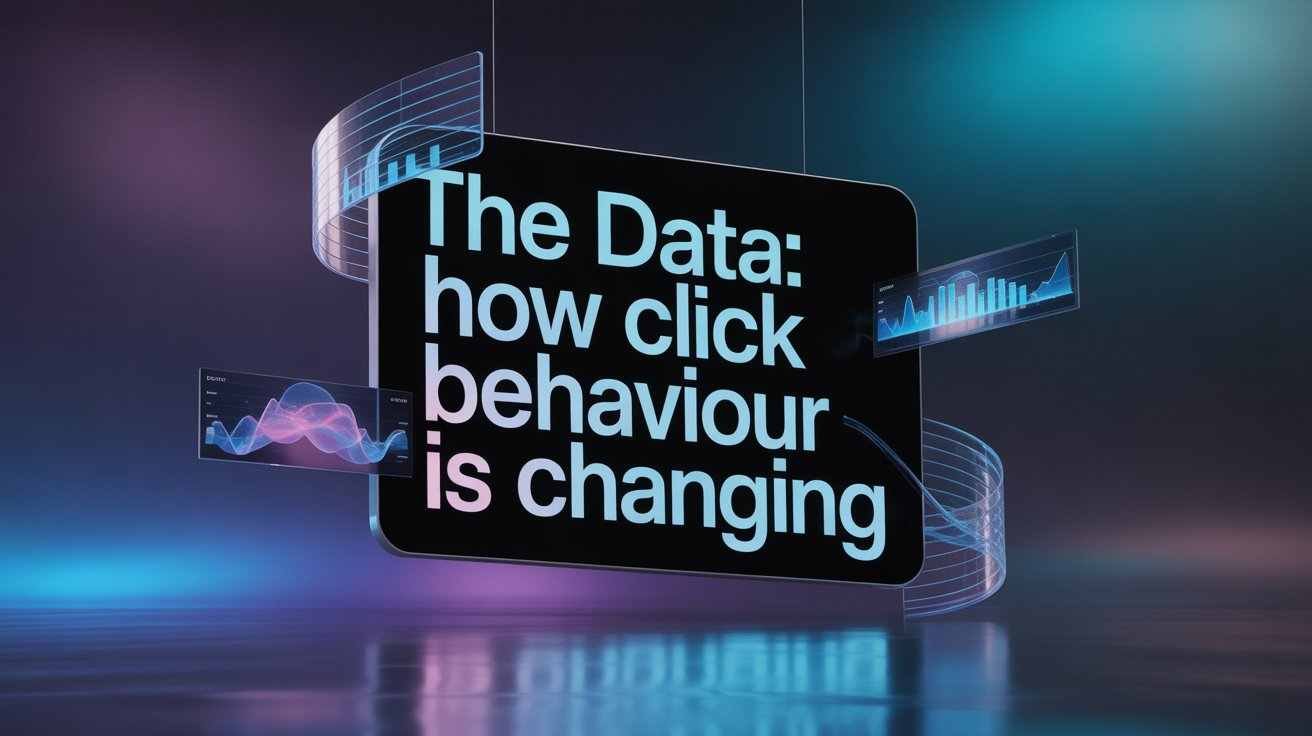 Click behavior is undergoing a measurable shift as Google expands AI Overviews, with multiple large-scale analyses showing that informational queries see reduced organic engagement when AI-generated summaries appear above traditional results. For Zero-Intent SERPs, where users begin with broad or ambiguous goals, this on-page answer experience satisfies more lookups without a site visit, redistributing attention toward on-SERP units and away from classic blue links.
Click behavior is undergoing a measurable shift as Google expands AI Overviews, with multiple large-scale analyses showing that informational queries see reduced organic engagement when AI-generated summaries appear above traditional results. For Zero-Intent SERPs, where users begin with broad or ambiguous goals, this on-page answer experience satisfies more lookups without a site visit, redistributing attention toward on-SERP units and away from classic blue links.
Across hundreds of thousands of keywords, AI Overviews correlate with a pronounced drop in top-position CTR: an analysis of 300,000 informational queries found the presence of an AI Overview was associated with a ~34.5% lower CTR for position 1 compared to similar keywords without AI Overviews, highlighting the compression effect of AI summaries on the organic listings beneath them. Complementary reporting shows the impact isn’t uniform but is directionally consistent—Search Engine Land’s synthesis cites both the 34.5% decline and additional decreases for lower-ranked positions, indicating steeper losses below the fold when AI Overviews crowd the viewport.
Non-click interactions—zero-click behaviors—are widespread and rising, especially on mobile, reinforcing the decoupling of impressions from clicks as rich results do more work in-SERP. Recent zero-click studies estimate that a majority of searches end without a visit to the open web, underscoring how features like featured snippets, knowledge panels, PAA, local packs, carousels, and AI Overviews increasingly resolve tasks on the results page itself. This aligns with the “Great Decoupling” observed in Google Search Console data: impressions climb while clicks fall, a pattern tied to AI Overviews double-counting visibility opportunities and to more answers being completed on the SERP—especially in Zero-Intent SERPs where intent gets shaped by on-page modules before any click is required.
Why This Is Happening Now
Google’s AI-generated summaries and a denser mix of rich SERP features have moved into prime, above-the-fold real estate, giving searchers immediate answers and compressing the visibility of traditional listings beneath them, which in turn depresses organic CTR—studies across 200,000–300,000+ keywords show that when AI Overviews appear, position‑1 CTR can drop by about 34.5% compared with similar queries without AI Overviews, a pattern that’s especially acute on informational and Zero-Intent SERPs where users arrive with broad needs and accept in‑page answers.
This on-page prominence isn’t isolated to AI Overviews; SERP elements like featured snippets, knowledge panels, carousels, and local units collectively satisfy more intent without clicks, contributing to rising zero‑click behavior and a documented dip in organic click share year over year in major markets.
Mobile-first behavior intensifies this shift because most searches now happen on small screens where above‑the‑fold space is scarce and answer units dominate the initial viewport, making scannable AI Overviews, snippets, and local results more likely to resolve the query without a site visit on Zero-Intent SERPs.
Voice-led discovery compounds the preference for instant, concise answers, with industry reporting showing sustained growth in voice usage and the framing of search as conversational follow‑ups—exactly the context where generative overviews and PAA modules steer users toward resolution inside the SERP rather than prompting immediate clicks. The net effect is the “decoupling” many teams see in Search Console—impressions up, clicks down—as richer layouts and AI summaries handle more of the early‑journey exploration right on the results page.
At the same time, Google-owned surfaces absorb a larger share of user interactions: local intent frequently resolves within the Maps‑powered Local Pack via calls, directions, and reviews, while product and media discovery routes users into Shopping and YouTube elements that occupy visible SERP space and capture engagement before external sites, trends that are increasingly visible on Zero-Intent SERPs
. Behavioral studies indicate that a substantial portion of local searchers click a Map Pack result and that Shopping and other Google modules attract meaningful interaction, which further redistributes attention from classic organic links to Google’s integrated experiences in the moments that matter. In combination, AI Overviews’ summarization, mobile and voice demand for instant answers, and the gravitational pull of Google’s own properties explain why clicks consolidate into on‑SERP features and why optimizing for presence and citation within those features has become essential in 2025.
The New KPI Reality: From Traffic to On-SERP Visibility
Reframing success metrics in an AI-first landscape means shifting from rank-and-click vanity to visibility and attribution inside the results page itself, especially for Zero-Intent SERPs where users begin broad and accept in-page answers.
Core KPIs now include impressions, citation presence in AI Overviews, featured snippet share, and local pack visibility, because AI Overviews correlate with materially lower organic CTR for position 1—roughly a 34.5% decline across 300,000 informational keywords—so being seen and cited within the SERP has become as critical as traditional clicks. Tracking should prioritize: impression trends in Google Search Console to diagnose “decoupling,” featured snippet ownership/retention rates, AI Overview citation share for target queries, and local pack visibility/actions (calls, directions), acknowledging that Search Console impressions can rise while clicks fall when AI modules and rich results satisfy intent on-page.
Brand lift via citations remains a tangible outcome even when traffic dips, because AI Overviews often appear above all listings and prominently attribute sources, making repeated citation a trust and authority signal that influences recall and downstream conversions.
Multiple syntheses show AI Overviews depress click share to traditional organic links, but the sources cited inside the Overview gain disproportionate exposure; some analyses also note branded queries can see CTR resilience or gains versus generics, underscoring how citation-led presence can nurture brand preference in Zero-Intent SERPs where the journey is still being shaped. Teams should measure “citation frequency” and “citation share” across tracked keywords, correlate these impressions with assisted conversions, and monitor referral patterns from AI layers to quantify brand impact beyond last-click.
Segmenting keyword targets by “clicked potential” versus “on-SERP exposure” potential helps align goals and budgets with how different SERPs behave. For keywords that frequently trigger AI Overviews, PAAs, and knowledge elements—common in Zero-Intent SERPs—optimize for inclusion: concise answer blocks, schema-supported facts, and entity clarity to win snippets and AI citations, then report on impression lift, snippet share, AI citation share, and local interactions as primary outcomes.
For keywords with lower AI/feature density and higher transactional intent, maintain classic CTR and conversion KPIs, while using SERP-feature tracking to flag when queries shift into AI-dominated layouts. Implement practical measurement: build trackers for AI Overview mentions/citations, monitor snippet retention, and use Search Console filters to compare impression vs. click trajectories across “exposure-first” clusters versus “click-first” clusters to prove value and steer investment.
Strategic Implications for SEO and Content
Optimize for answer inclusion, not just rankings: prioritize formats that AI Overviews and SERP features can extract—concise 40–60‑word answers, step lists, tables, and FAQs—to earn citations and on‑page visibility on Zero-Intent SERPs where users accept in‑SERP resolutions.
Build Answer Engine Optimization (AEO) into workflows: design content to directly answer specific questions with clarity, schema, and entity precision so it’s eligible for featured snippets, PAAs, and AI Overview citations, which now drive a growing share of discovery without clicks.
Target long‑tail and question keywords: informational, 4+ word, question‑led queries are disproportionately likely to trigger AI Overviews and PAA; align clusters around how‑tos, comparisons, and definitions to surface in Zero-Intent SERPs and guide early‑stage exploration Structure pages for machine readability: deploy schema types like FAQ, HowTo, Article, Organization, Product, and LocalBusiness; use clear headings, bullet points, and scannable blocks to maximize eligibility for featured snippets, PAA pulls, and AI citations
Strengthen entity signals and topical authority: consolidate NAP and brand data, interlink pillar/cluster content, and back cornerstone pages with expert input and references to increase trust and the likelihood of being cited in AI summaries across Zero-Intent SERPs.
Measure and iterate for on‑SERP success: add KPIs for AI Overview citation frequency, featured snippet share, PAA appearances, and local pack visibility alongside impressions vs. clicks to capture performance where CTR pressures persist due to AI modules.
Diversify content formats to match SERP surfaces: complement articles with videos, infographics, tools, and short FAQs to win carousels, video packs, and snippet variants that dominate above‑the‑fold real estate on Zero-Intent SERPs.
Prioritize credibility signals (E‑E‑A‑T): highlight author experience, cite sources, and provide original insights/data to increase selection odds for AI Overview citations and featured snippets in sensitive categories impacted by AI expansions.
Segment keyword strategy by SERP feature intensity: dedicate “exposure-first” clusters to AI/PAA/snippet-heavy pages where citation visibility is the goal, and “click-first” clusters to lower‑feature, transactional queries where classic CTR and conversion outcomes still dominate.
Prepare for continuous SERP change: monitor which queries trigger AI Overviews and adjust briefs accordingly; Semrush data shows rising AI Overview coverage, particularly for informational intents, making adaptability central to sustaining visibility in Zero-Intent SERPs.
Winning On-SERP: Technical Foundations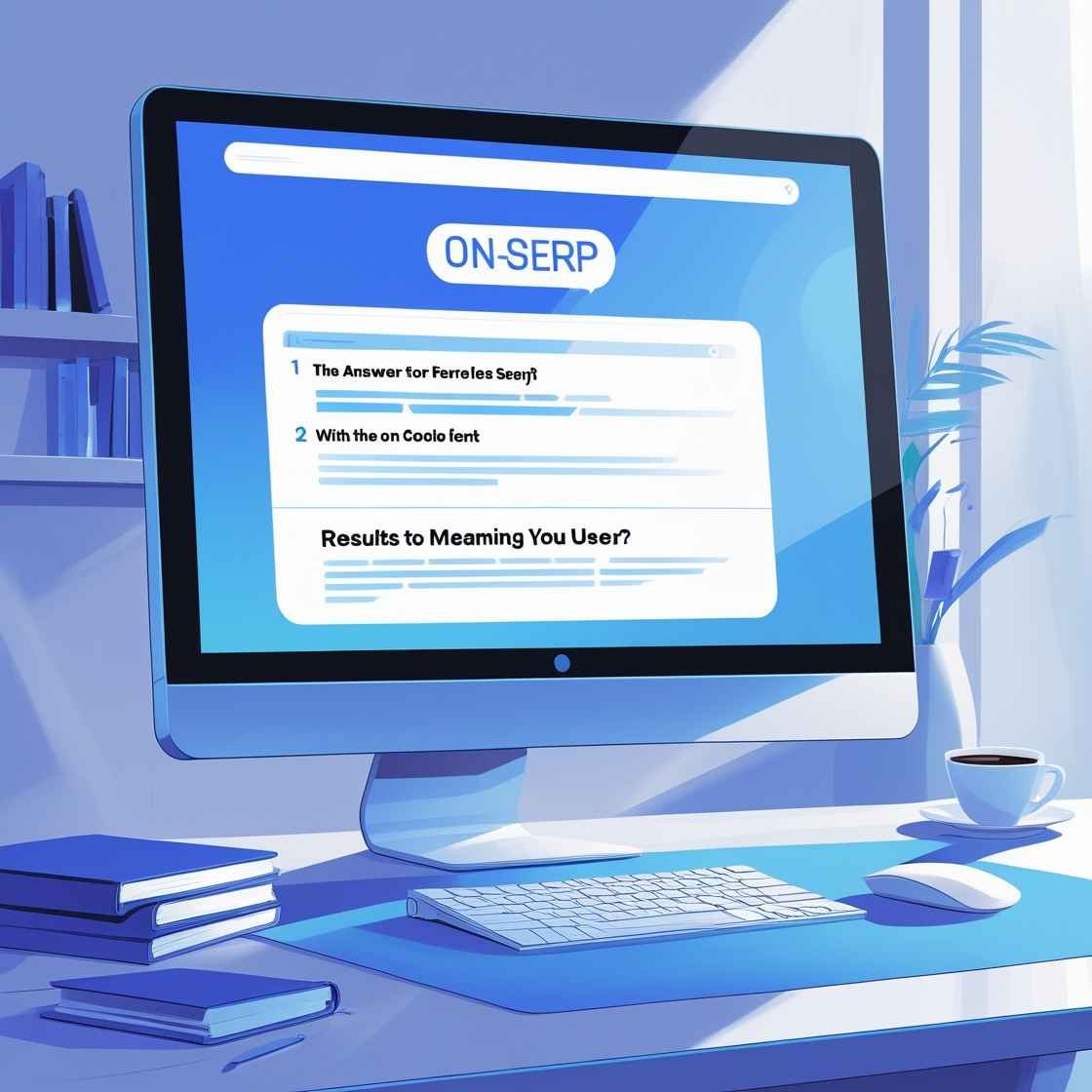
Implement robust structured data to become machine-readable: add JSON‑LD for Article, FAQ, HowTo, Product, Organization, and LocalBusiness where relevant, ensuring the markup matches on‑page content and passes Google’s Rich Results tests; structured data increases eligibility for rich results and helps systems surface content inside AI layers—vital on Zero-Intent SERPs where users accept in‑SERP answers.
Engineer pages for snippet extraction: lead sections with a 40–60‑word direct answer, use question‑led H2/H3s, ordered steps, tables, and tight summaries; combine with FAQ and HowTo schema to raise odds of featured snippets and list/steps displays that appear above the fold.
Strengthen entity signals and knowledge coherence: define clear “entity homes” (pillar pages), use schema.org properties like about, mentions, and sameAs to connect brand, product, and topic entities, and keep attributes consistent across site and profiles so Google’s Knowledge Graph can confidently attribute and elevate your content in SERP features and AI summaries.
Maintain markup fidelity and validation discipline: ensure structured data reflects visible content, avoid spammy or irrelevant fields, and validate regularly with Google’s Rich Results Test; inaccurate markup can disqualify pages from rich features and reduce inclusion odds in AI Overviews on Zero-Intent SERPs.
Optimize for mobile-first rendering and speed: prioritize Core Web Vitals, responsive layouts, and CLS-safe components so rich features and AI layers can confidently surface your content; mobile viewports amplify above‑the‑fold constraints where snippets, PAAs, and AI Overviews dominate.
Local technical essentials: for entities with proximity intent, implement LocalBusiness schema, keep NAP consistent, and fully optimize Google Business Profiles to win Map/Local Pack outcomes that often resolve without clicks—crucial exposure for Zero-Intent SERPs at the discovery stage.
Content freshness and revision metadata: update facts, dates, pricing, authorship, and last‑modified signals so extractive systems and AI Overviews prefer your content as a current source; freshness is a recurring selection criterion for in‑SERP summaries and snippet rotation.
Build a GEO/AIO checklist into briefs: every page should specify target SERP features, required schema types, the canonical “quick answer” block, supporting FAQs, and entity linkages; track appearances in AI Overviews and featured snippets to iterate toward durable on‑SERP visibility in Zero-Intent SERPs
Content Patterns That Earn Citations and Snippets
Direct‑answer blocks that are concise, scannable, and positioned high on the page are consistently favored for paragraph snippets, with multiple guides showing that 40–60 words is an optimal range for definition‑style answers that Google can lift into position zero—an approach that aligns well with Zero-Intent SERPs where users accept fast, in‑SERP resolutions. Bulleted or numbered steps are effective for process and how‑to queries because list formatting mirrors how list and step snippets are rendered, increasing extractability for featured snippets and related modules. Comparison tables help win table‑type snippets and clarify choices at a glance; well‑structured HTML tables and descriptive headers make it easier for search systems to understand and feature the content inline on the results page.
FAQ clusters mapped to People Also Ask (PAA) questions expand on‑SERP presence by aligning page sections with real user follow‑ups that Google surfaces beneath initial results, which is particularly useful on Zero-Intent SERPs where intent is being shaped in real time. Building FAQs from PAA-derived queries ensures coverage of adjacent topics and increases the odds of short answers being pulled into PAA expansions and other answer units. Using question‑led H2/H3 headings that mirror PAA phrasing further improves machine understanding and selection for snippet‑eligible blocks across related queries.
Clear sourcing and topical depth raise the likelihood of being cited in AI Overviews because selection tends to favor pages that demonstrate authority, credible attribution, and structured presentation of answers, not just brevity. Practices that help include explicit authorship with bios, transparent dates and updates, outbound citations to reputable sources, and appropriate schema (e.g., Article, FAQ, Author) to reinforce expertise and page quality for inclusion in AI‑generated summaries common on Zero-Intent SERPs. Combining concise, snippet‑ready answer blocks with comprehensive, well‑sourced depth on the same page balances extractability for citations with the substance that AI Overviews and rich results look for when attributing sources.
Local and Zero-Click: Owning the Pack
Winning local visibility in Zero-Intent SERPs hinges on mastering Google Business Profile (GBP) so key information is resolved directly in the Map Pack, where many searches end without a website click. Optimizing core fields and categories is foundational: select the most specific primary category and relevant secondary categories to align with how Google matches local intent and surfaces listings in the 3‑Pack. Enrich attributes (e.g., accessibility, payment options, service offerings) to appear for nuanced filters and query refinements that shape discovery on the SERP.
Maintain an active review strategy—prompt, respond, and resolve—to improve prominence and trust signals that influence local rankings and user selection. High-quality photos and short videos increase engagement and conversion propensity in the listing, while frequent Posts/Updates (offers, events, new services) keep the profile fresh and eligible for more in‑SERP surfaces. These GBP enhancements concentrate decision-making in the Pack, supporting zero‑click outcomes like calls and direction requests that are especially common on Zero-Intent SERPs where the user starts broad and chooses directly from on-page options.
Local intent triggers such as “near me,” city modifiers, and implicit geo-intent queries commonly return Map Packs, where zero‑click conversions are the norm via tap‑to‑call, directions, and bookings. Optimizing for these micro‑conversions requires precise NAP consistency, service-area coverage setup, and enabling native actions: add call buttons, integrate booking/reservations where applicable, and configure messaging to capture demand without a site visit. Encourage review keywords that mirror high‑value queries (e.g., “emergency plumber,” “open late”) to reinforce relevance for intent‑driven retrieval, and ensure hours, holiday schedules, and inventory or menu data are accurate so the listing answers decisive questions on the spot.
Because mobile viewports compress above‑the‑fold space, a complete, media‑rich GBP with current categories, attributes, reviews, photos, and timely updates will outcompete a higher-ranking but under-optimized listing, capturing zero‑click actions directly from the Pack—an essential capability as local discovery on Zero-Intent SERPs increasingly resolves inside Google’s interface.
What Matters in a Zero-Click World
In an environment where answers increasingly live on the results page, reporting must capture visibility and influence that occur without a site visit—especially on Zero-Intent SERPs where discovery begins broad and is shaped by on-page modules.
On-SERP KPIs: Track featured snippet share for priority queries (ownership and retention over time), PAA appearances for your answers across related questions, knowledge panel presence and accuracy for your brand/entity, and AI Overview citation frequency to understand how often your pages are sourced inside AI summaries. Pair these with impressions and in-SERP actions (e.g., calls, directions, bookings for local) to quantify impact that traditional click metrics miss.
Distinguish “clicked vs. non-clicked” keyword segments in reporting and forecasting: Segment keyword sets by SERP feature intensity and historical CTR behavior. “Non-clicked” segments are those that frequently trigger snippets, PAA, knowledge elements, or AI Overviews and tend to generate impressions without visits; success here is measured by on-SERP exposure (snippet share, citation frequency, panel visibility). “Clicked” segments are lower-feature or more transactional queries where classic CTR, sessions, and conversions remain primary. Build dashboards that compare impression trajectories, snippet/citation share, and downstream assisted conversions for non-clicked clusters versus traffic, conversion rate, and revenue for clicked clusters. This split enables realistic forecasting, budget alignment, and clear attribution of value in a zero-click reality.
Zero-Intent to Demand Creation: Guiding Ambiguous Journeys
Zero-Intent SERPs are where discovery starts broad and unformed, so the strategic play is to shape intent rather than chase it. Build thought leadership hubs anchored in definitive pillar pages that explain core problems, frameworks, and category narratives, then extend them with explainer clusters (how‑tos, comparisons, checklists, glossaries) that answer the natural follow‑ups a curious searcher asks next. Each asset should open with a concise, snippet‑ready answer and expand into credible depth, using clear headings, FAQs,
and visuals so it’s eligible for on‑SERP extraction while still delivering substance for evaluative readers. Treat these hubs as living resources: refresh stats, cite trustworthy sources, and add original perspectives or data to earn citations in AI summaries and to be featured when Zero-Intent SERPs present overviews and People Also Ask pathways. Internally link from pillars to cluster articles (and back) with intent-led anchor text to guide readers along a logical journey—from “what is” to “how it works,” “pros and cons,” “alternatives,” and finally “solutions”—so exploration naturally progresses toward brand affinity and later conversions.
Map SERP elements to funnel stages and build deliberate handoffs from on‑page answers to brand outcomes. At the top of the funnel, target featured snippets, PAAs, and AI Overview citations with definition blocks, step lists, and comparison tables to secure visibility where ambiguous queries originate. Mid‑funnel, aim for review carousels, “best of” roundups, and video packs by publishing side‑by‑side comparisons, buyer’s guides,
and short explainer videos that address selection criteria and objections. Near conversion, optimize for local packs, product snippets, and sitelinks by aligning structured data, pricing and inventory cues, and clear CTAs (demos, calculators, templates).
Use soft bridges from each stage to branded destinations: include memorable brand phrasing in answer blocks, seed navigational prompts (“[Brand] vs alternatives,” “[Brand] pricing”), and offer downloadable resources or tools that incentivize a branded follow‑up search or direct visit. Instrument the journey with segment-based KPIs: track on‑SERP visibility (snippet/PAA share, citation frequency) for ambiguous queries, rising branded search volume and return visitors as indicators of shaped demand, and assisted conversions from mid‑funnel assets. The goal is to let the SERP do early education while every touch nudges the searcher from Zero-Intent SERPs toward brand-seeking behavior and high‑intent clicks that close.
Risk Management: Diversifying Beyond Google
A zero-click reality makes it essential to build durable, direct demand streams that don’t depend on fluctuating SERP layouts—especially for discovery on Zero-Intent SERPs where early research often resolves in-page. Develop owned audiences via newsletters that deliver consistent value (original insights, explainers, data roundups) and nurture recall with predictable cadences and memorable subject lines. Build communities on platforms where conversations compound—Slack/Discord groups, LinkedIn groups, or niche forums—so questions, answers, and peer proof accumulate around the brand. Launch a podcast to capture commute and multitask moments; use episodic series, expert interviews, and thematic seasons to create habitual listening
. Lean into social search by publishing keyworded shorts and carousels on Instagram, TikTok, and LinkedIn that answer specific questions succinctly, then funnel engaged users to owned properties. Expand on YouTube with searchable explainers, product walkthroughs, and “versus/best” comparisons; optimize titles, descriptions, chapters, and end screens to convert viewers into subscribers and site visitors. Together, these channels generate brand familiarity independent of ranking volatility and create repeatable touchpoints that persist even as on-SERP answers satisfy more early queries.
To leverage platforms where discovery still drives clicks and subscribers, tailor content to each ecosystem’s native intent and format.
On YouTube, prioritize high-retention scripts, strong hooks in the first 10 seconds, and chaptered long-form videos that match how users research (definitions, pros/cons, buyer’s guides), then pair them with companion shorts for broader reach. On LinkedIn, ship insight-dense posts, original charts, and contrarian takes that spark saves and discussions, and repurpose threads into newsletters to capture emails. On TikTok and Instagram, produce rapid-fire how-tos, checklists, and “X mistakes to avoid” clips that mirror question-led discovery; link to a Link-in-bio hub to convert attention into subscriptions. In email, segment by interest and lifecycle, and offer lead magnets (playbooks, calculators, templates) that earn opt-ins and drive consistent return traffic. For communities, seed weekly prompts,
AMAs and office hours to sustain engagement and surface user-generated insights that feed future content. By treating these channels as primary discovery engines—not mere syndication—brands mitigate reliance on any single SERP experience and create resilient pipelines of clicks, subscribers, and advocates that compound over time
How Teams Should Adapt
Keyword triage: categorize by SERP feature intensity and objective (traffic vs. visibility).
Cluster queries into A) exposure-first (AI Overviews, featured snippets, PAA, knowledge/local panels frequently present) and B) click-first (lower feature density, higher transactional intent).
For exposure-first clusters—common on Zero-Intent SERPs—optimize for on-SERP inclusion and attribution (snippet-ready answers, schema fidelity, entity clarity). Measure impressions, snippet share, AI citation frequency, and local interactions as primary outcomes.
For click-first clusters, prioritize classic acquisition goals: landing-page depth, persuasive UX, rich assets, and conversion intents. Measure CTR, sessions, and revenue/conversions. Reassess cluster assignment quarterly as SERP layouts evolve.
Content briefs that specify snippet targets, FAQ angles, and schema requirements.
Start every brief with a “quick answer” mandate: a 40–60 word definition or resolution that can be lifted for a paragraph snippet, followed by a step list or table if applicable.
Enumerate 5–10 PAA-aligned FAQs sourced from audience research and SERP recon; require each FAQ to include a concise, self-contained answer block that can stand alone on Zero-Intent SERPs.
Prescribe required structured data (Article, FAQ, HowTo, Product, LocalBusiness, Organization) and entity links (about/mentions, sameAs, author info). Include internal links to pillar “entity homes” to reinforce knowledge coherence.
Specify freshness cadence, source attribution standards (citations, dates, original insights), and media requirements (images/video) to win diverse SERP surfaces (snippets, carousels, video packs).
Cross-functional cadence: SEO, content, PR, and local teams align on entity signals.
SEO x Content: maintain an entity map (brand, products, categories, key people) with canonical “home” URLs, consistent naming, and anchor text standards; review SERP feature coverage and AI citation logs in a shared dashboard.
PR x Content: coordinate thought leadership and digital PR to earn authoritative mentions that strengthen entity authority and increase likelihood of selection in on-SERP summaries—especially valuable on Zero-Intent SERPs where early trust shapes journeys.
Local x SEO: synchronize Google Business Profile categories, attributes, hours, and updates with site LocalBusiness schema and location pages; align review generation and response playbooks to improve Map Pack prominence and zero-click conversions.
Analytics x All: report by cluster (exposure-first vs. click-first). Track featured snippet share, PAA appearances, knowledge/local panel presence, AI citation frequency, impressions vs. clicks, and assisted conversions. Use these insights to re-prioritize briefs, refine schema implementation, and shift budgets toward resilient opportunities.
Case Snapshot Patterns
Informational head terms: expect lower CTR; target snippet/AI Overview citation for brand lift.
For broad, top-of-funnel queries, competition and rich results compress organic clicks, so success hinges on visibility inside the results page itself. Lead with a 40–60 word definition block to qualify for paragraph snippets, add comparison tables and step lists for alternate snippet formats, and reinforce authority with clear sourcing and expert bylines to increase selection odds for AI Overview citations. Treat these pages as brand billboards on Zero-Intent SERPs: measure impressions, snippet ownership, and citation frequency as primary outcomes, and weave subtle branded phrasing into quick answers to nudge later navigational searches.
Niche how-tos: design for featured snippets, HowTo schema, and PAA expansion.
For specific procedural tasks, structure content to mirror extractable answer patterns: a concise outcome statement, followed by numbered steps with scannable sub-steps and required materials. Implement HowTo schema that faithfully matches visible contenPeople Also Ask phrasing. This increases eligibility for list/step snippets, rich result displays, video packs, and repeated PAA pulls—valuable exposure on Zero-Intent SERPs where users are still clarifying the exact solution they need.
Local services: optimize Google Business Profile to capture zero-click conversions via calls and directions.
For proximity-driven queries, prioritize the Map Pack by selecting the most specific primary category, adding relevant secondary categories, and completing attributes (payments, accessibility, services). Maintain accurate NAP and hours (including holidays), enable call, message, and booking actions, and publish timely Posts with offers or updates. Encourage review keywords that reflect high-intent searches and upload fresh, high-quality photos. This setup channels decisions directly inside the listing—calls, directions, and bookings—delivering zero-click wins from Zero-Intent SERPs where customers choose providers straight from the Pack.
Conclusion
Zero-click and zero-intent SERPs are a durable reality, not a blip.
The winners will optimize for presence, precision, and provenance—whether or not a click occurs
Notes on evidence and variability:
Multiple independent reports show declining organic clicks and rising zero-click behavior, though exact percentages vary by device, region, and methodology, so the article should present ranges and explain differences across studies.
also. don’t forget to read our more blogs on onlinedigigyan


